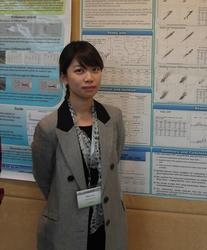
Jihye Lee
Doctoral studente-Mail: ji1222(at)kangwon.ac.kr
Kangwon National University
192-1 Hyoja-Dong, Gwangwon-do
Chuncheon 200-701
Republic of Korea
http://www.kangwon.ac.kr/english/main/main.php
Dept. of Environmental Science
Abstract: Several models for estimated vegetation productivity have been developed by combining remote sensing data with carbon cycle processes. NASA Earth Observing System (EOS) currently produces a regular global estimate of vegetation primary productivity (both GPP and NPP) and annual net primary productivity (NPP) of the entire terrestrial earth surface at 1 km spatial resolution. Remote sensing imagery allows us to examine the terrestrial biophysical processes across broad regions, but there are many challenges in accurately capturing the terrestrial processes using the remote sensing techniques due to many interrupting factors, including potential cloud contamination, choice of alternative algorithms, and the model parameterization. MODIS GPP and NPP algorithms use meteorological data provided by the NASA Data Assimilation Office (DAO). Hence, the sub-pixel heterogeneity or complex terrain effects on meteorological conditions are hardly reflected due to coarse spatial resolutions of the DAO data (a resolution of 1° × 1.25° in latitude and longitude). In this study, we utilized a higher spatial resolution dataset from a regional-scale meteorological prediction model (i.e., WRF) to provide more detailed meteorological variables in addition to the DAO data for cloudy days. Furthermore, remote sensing input variables for GPP and NPP estimation (i.e., FPAR and LAI) were improved to reduce cloud contamination effects on the variables. New MODIS GPP and NPP datasets were retrieved with WRF meteorology and cloud-filled MODIS data for the Soyang River Basin for a period covering the last 10 years. The derivatives included daily minimum air temperature, daytime mean VPD (Vapor Pressure Deficit), and daily solar radiation. Our preliminary results indicate that the use of MODIS and WRF data can provide a useful tool for estimating GPP, NPP, and subsequently,crop yield.
Keywords: MODIS, WRF, vegetation primary productivity, crop yield
project description in detail from proceedings of 2011 TERRECO Science Conference GAP
